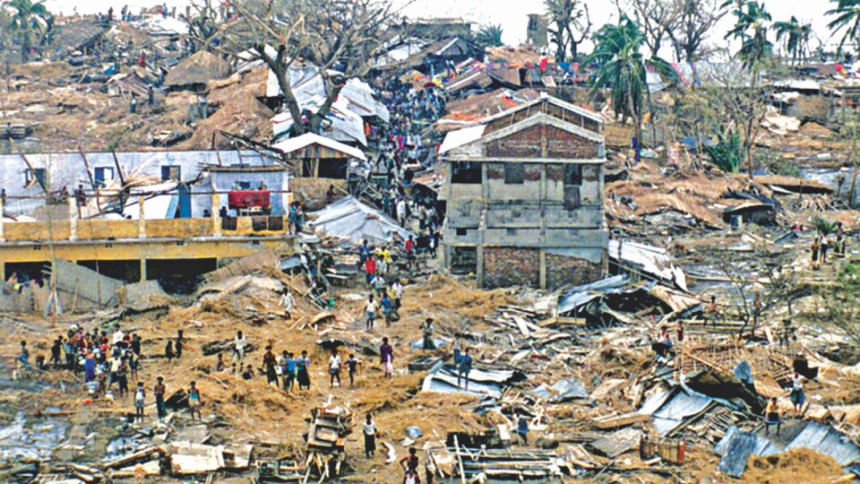In the wake of Cyclone Mora

As the news of the cyclone named Mora (a Thai word which means 'star of the sea') erupted on social and traditional media, I couldn't but recall the 1991 cyclone. While we experienced torrential rains in Dhaka, Chittagong and other coastal cities/islands like Swandip and St. Martin's were being washed bare.
We had visited our extended family members in Chittagong soon after the cyclone. Our cousins filled us in: there were balls of fire in the air on that night and the next day when they emerged there were dead bodies stuck to trees.
That mental image never left me. It's almost as if I had seen it myself. That's the thing with children's imagination, I suppose, they can be surprisingly realistic.
I remember how disease came with death as it became difficult to bury the dead, as the rains wouldn't stop. I remember our Bangla teacher's husband went to the coastal region to provide relief, but was taken ill, and subsequently died. As a 10-year-old then I thought of it as the worst thing that had happened in the world.
Those were the days when Bangladesh made the news for reasons such as these – natural disasters, cyclones, floods, and its human cost, and nothing else.
Mora made international news, like old times, but the news read differently. The BBC, for example, said ahead of the cyclone: "Bangladesh tries to evacuate 1 million people." Early reports about the cyclone have very low estimates of the number of people who died – seven to be exact – which means that the human cost has not been high yet, although reports indicate that various places have been "flattened."
This is incredible news as far as disaster preparedness and management goes.
However, disasters like these have a way of disproportionately affecting the most disadvantaged. That among the worst affected by Mora are the people in the Rohingya camps exemplifies this statement.
The effects of disaster are wide-ranging, from experiencing prolonged displacement to trauma to violence. The next steps should involve housing the thousands of people who have been displaced, giving them access to basic necessities including food and clothing, providing mental health counselling to those who experience disaster-related stress, and preventing violence against women and children.
As post-disaster work begins, my best hope is that relief, including food and clothing, reaches those who need it the most. I remember, for example, the relief-related corruption in the past which meant that certain people in power amassed great wealth by siphoning off goods meant for the disaster-stricken people while they starved.
I hope such forms of corruption no longer occur.
Symptoms of disaster-related stress include disorientation, headache, depression, mood swings, low attention span, and fear of crowded places. To overcome some of these symptoms individuals need to practise self-care to maintain their mental and physical health by exercising, meditating, and eating well. If symptoms like recurrent nightmares about the hurricane, for example, persist for more than two weeks, individuals probably need help from mental health professionals, as it may be indicative of post-traumatic stress disorder (PTSD). Not everyone responds to trauma in the same way, which means care must be taken to not make presumptions about individuals based on their traumatic experiences. Instead, cues should be taken from responses to their experiences. We must also remember that in addition to direct victims of disaster, those who respond to disasters as part of rescue efforts are also at heightened risk of experiencing PTSD.
A problem that is heightened at times like these, but is often ignored amidst apparently grander problems, is violence against women. A good example comes from post-tsunami Sri Lanka. After the tsunami in 2004 reports of rape, sexual assault, physical assault, and gang rapes were on the rise in the country while 30,000 people were killed and more than 860,000 displaced. Similarly, a study from 1992 shows that in Bangladesh, sexual violence was on the rise after the aforementioned 1991 cyclone. Studies from the United States and Canada, similarly, indicate that violence against women, including domestic violence, in the aftermath of disaster, is indeed common. In other words, disaster research consistently shows that natural calamities like cyclones bring women disproportionate hardship, which means their vulnerabilities and associated needs have to be seen through a gender-informed lens.
This means we need to think of the needs women have in terms of menstrual hygiene and sanitation; the added vulnerability of losing their communities and social support as they move to shelters where they are at higher risk of stranger rape as well as partner violence. We need to think about the stress that comes with loss of livelihood and housing, and how that may cause relationships to become strained, or even change traditional gender roles. We need to think about the effect of disrupted lives and disrupted roles on women, because women often bear the deepest scars of those changes. We need to think about the role of relief workers and how their positions of power may become a source of coercive control for women.
We need to be particularly aware of this problem because the incidence of violence against women in Bangladesh is among the highest in the world, not counting conflict zones like Afghanistan. That our "normal" levels of violence are so high means that when violence is exacerbated by incidents like cyclones, women and children need further protection, particularly low-income, marginalised ones who are at the highest risk of experiencing violence.
So, while I applaud the structural changes that led to this level of disaster-preparedness in the face of natural disasters, I would like to call for substantial structural change with equal zeal to dismantle the patriarchal system that makes women and children vulnerable in the aftermath of such disasters.
The writer is Assistant Professor, School of Social Work, University at Buffalo, State University of New York.

 For all latest news, follow The Daily Star's Google News channel.
For all latest news, follow The Daily Star's Google News channel. 



Comments